A digital nomad's guide to spending 15 days in Cape Verde
This is a live blog entry that will be updated daily until the end of my trip, on November 29th. It includes a day-to-day description of my stay here that digital nomads, and those who work while they travel, might find useful.
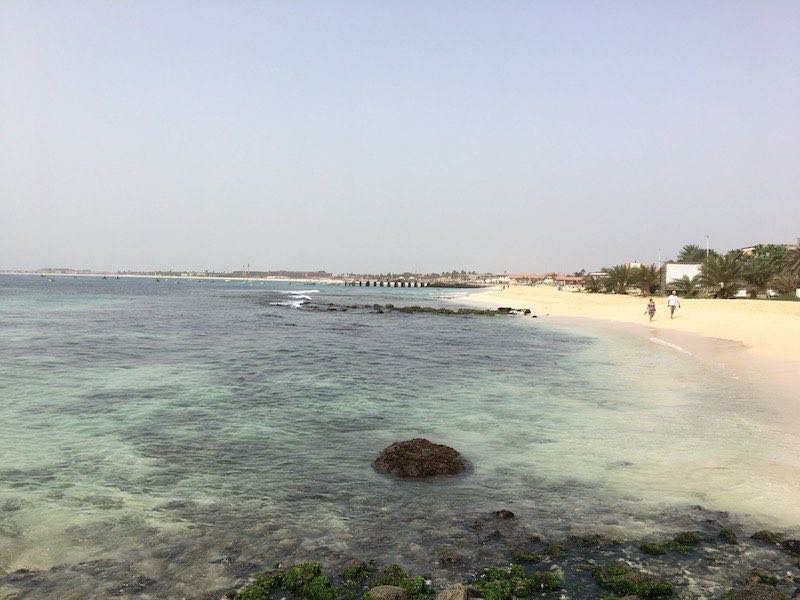
Like I did in my A Digital Nomad's Guide to Spending 25 Days in Bali and the Gili Islands, every day I included an all-you-need-to-know about a certain topic that is called Things you need to know.
Too long; didn't read
If you're looking for the TL;DR summary of this guide, it is the following.
I am spending 15 days in Cape Verde for mostly chilling & island hopping. However, I need to work on some side projects that will see me working here and there, so I can provide a comprehensive vision of how it is to travel & work while travelling in Cape Verde.
This guide is NOT for:
- Backpackers on a very limited budget.
- Couples or people looking for a romantic trip in high-standard hotels.
- People 100% on holidays.
This guide is for you if:
- You need to know where can you get work done every day.
- You know how to have fun when time is limited because of work.
- You want to be able to travel around regardless of the two above.
- You want to get a taste of everything in Cape Verde, regardless of the budget and/or prejudices.
Table of contents
I will link you to the parts that mention the following subjects:
Diary:
- Day 1: Arrival & check-in
- Day 2: Moving around Sal
- Day 3: Sport!
- Day 4: Live music!
- Day 5: Beaches!
- Day 6: Weekend!
- Day 7: Last day in Sal!
- Day 8: Flying to Fogo!
- Day 9: Hiking up Pico do Fogo!
- Day 10: Exploring Praia
- Day 11: Lazing around
- Day 12: Things to see in Praia
- Day 13: Back to Sal!
- Day 14: Definitely fell in love with Sal
- Day 15: Going back home (summary)
Quick insights:
- Getting around
- Food & drinks
- Working out
- Basics of Creole Language
- Pokémon Go!
- Bars & live music
- Water
- Airports & domestic flights
- Cleanliness
- Safety
- Currency
- Meeting locals & dating apps
- Drugs
- Essentials
- TL;DR (too long; didn't read)
Costs
I have compiled my daily expenses in a downloadable PDF file, so you can see the costs of the restaurants, SIM card, etc. With the day number and the name of the restaurant, you can browse this post to see the review.
Day 1: Arrival & Checkin
If you're wondering whether you can just show up in Cape Verde because you enjoy the thrill of booking everything last minute, you definitely can.
I decided to spend my holidays here barely 18 hours before the flight. I quickly Googled whether I needed a visa or vaccinations, and booked the flight right away.
So first things first: a quick Google search will tell you that you can buy your visa when you arrive (more on this later) and that while some vaccinations are advisable, none is really needed.
What made me decide for Cape Verde? Taking into consideration I'm only spending 15 days here, a flight longer than 5-6 hours wasn't advisable. Also, weather-wise is what I usually look for when I travel (25-30ºC all day round), it's got beach, reggaeton is not their main music and it's a safe country.
I packed a few summer clothes, my laptop, snorkeling equipment and here I am, after a stopover in Lisbon (too long for my taste).
I arrived on the midnight flight. Since I knew the visa could be bought on the spot, I didn't care much about researching how it was going to be. I found Gabrielle Lods' A digital nomad guide to Sal, Cape Verde to be very useful. Read it!
Once you hop off the airplane, you're directed to passport control. If you're not paying attention, you might get in the wrong lane, so be careful here lest you lose a lot of time. If you don't have a visa, take the line on the right. It is a very slow line, and most likely you will see how the other ones empty up before yours.
You can buy your visa by paying in cash or with credit card, which is extremely convenient. Both options cost 25 euro. Oh, forgot to mention, you can pay in euro everywhere in the country (just that instead of 110 CVE - Cape Verde Escudos - their exchange rate is 100).
The airport is small and doesn't have any sort of distraction. Thus, once you get your luggage back, you'll walk out to meet all sorts of taxi drivers.
I had arranged a pickup service with the airport, and took me to Pontao Hotel in Santa Maria, for 15 euro. It's a 12-15 minute car ride, so I found the price to be reasonable.
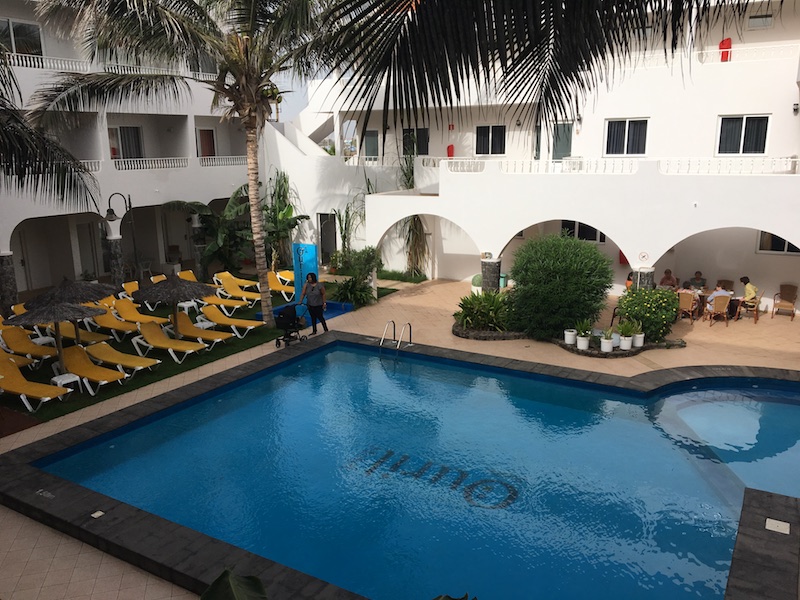
The hotel is nice enough. Clean, well-situated and quiet enough. Pretty much everyone I've met so far speaks not only Portuguese and Creole (both official languages in the island) but very good English and a fair share of other Latin languages (French, Italian, Spanish…). I'm so confused: I don't know which language to use first.
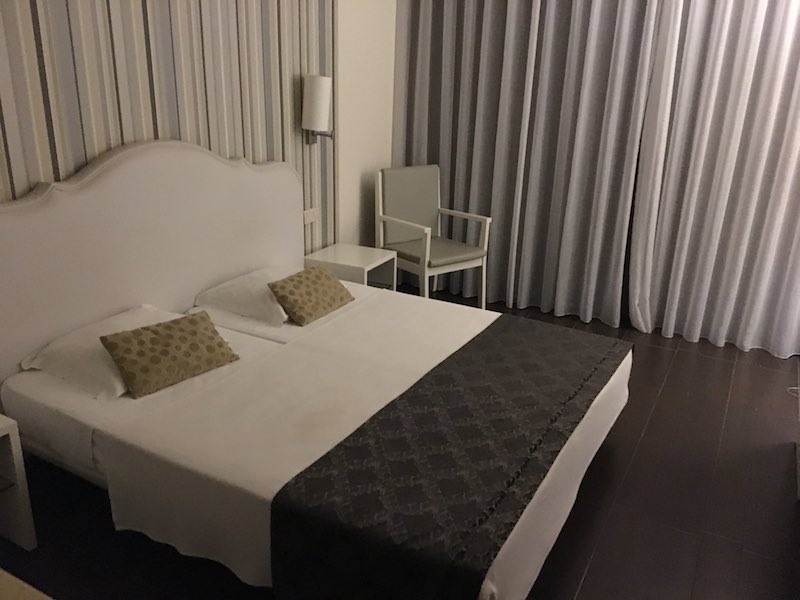
The hotel doesn't have a lot of facilities, but it's got a kickass pool and very surprisingly has got wifi. While they advertise it as "only in common areas", I've found it works from my room - best from the balcony, to be perfectly precise.
My first day literally consisted of getting into the hotel and going to bed.
Things you need to know: Getting around
- According to locals, most islands in Cape Verde are safe. All of them are during the day, only a couple of them are dangerous at night (but Sal isn't one of them).
- I haven't seen any problem hailing taxis in the street and people don't seem to mind doing it.
- Everything is within walking distance, but since it's all cobbled, wear proper shoes.
- Weather is pretty humid, as you can expect from an island in the middle of the ocean. Try to get a hotel room with AC.
- The first impression, at night, can be disappointing. Wait until you're well rested.
- Although it is not yet trendy, I find it to be very touristy.
- Good thing: no hipster places around. That means it's definitely not mainstream yet.
Day 2: Moving around Sal
Since I arrived on a Sunday night at about midnight, I decided to plan everything after the following day's breakfast.
Breakfast at Pontao Hotel is good. Nice selection of sweet pastries & cakes, all sorts of teas, juices & coffees, but a rather scarce selection of savory stuff: just ham and cheese, and some scrambled eggs with ham and cheese.
I had my first experience with connection problems early in the morning: I couldn't pay the hotel because of the reception of the credit card reader (or lack thereof). Later in the day, it worked fine, but they told me it's normal.

Another thing worth mentioning is that ATMs run out of cash (this was also mentioned in the guide I linked above), so I had to try a couple of them before finding one with cash, to get their currency.
However, I wouldn't worry much: most places accept credit card, and all of them accept euro, so it's not very likely that you won't be able to pay.
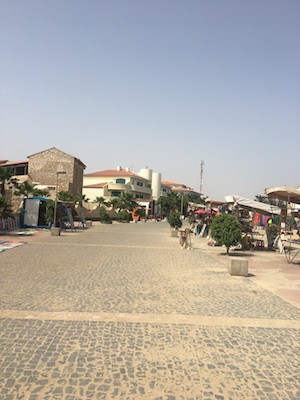
The first thing I've bought, it's been a local sim card. Since I will be travelling around, and I have a very limited memory retention, I like exploring the world using my cellphone.
I've bought a Unitel sim card with 10 Gb of data (no calls) for about 25 euro. So far, it had been working great until dinner time, but I assume I might've gone over the daily limit (if there is one), so I'll find out tomorrow.
There are plenty of supermarkets and local cellphone shops where you can buy stuff. I am, however, surprised at the prices.
I find the prices to be more expensive than in Barcelona. A coffee might cost 2-3 euro, a main dish 10-20 euro and a dessert 4-6 euro.
My first day in a new city I use it to soak up as much local knowledge as possible, to get orientated and to collect all the essentials so I can enjoy the rest of my trip.
I've walked around the city, exchanged money, bought the sim card and other amenities and tried a couple of restaurants.
One of them, for lunch, is the Palm Beach. Allegedly, and according to Foursquare, the best-rated place in town. In all fairness, I wasn't very hungry so I ordered half a chicken and a mineral water. Tasty, but nothing to write home about. Will have to come back for a proper meal.
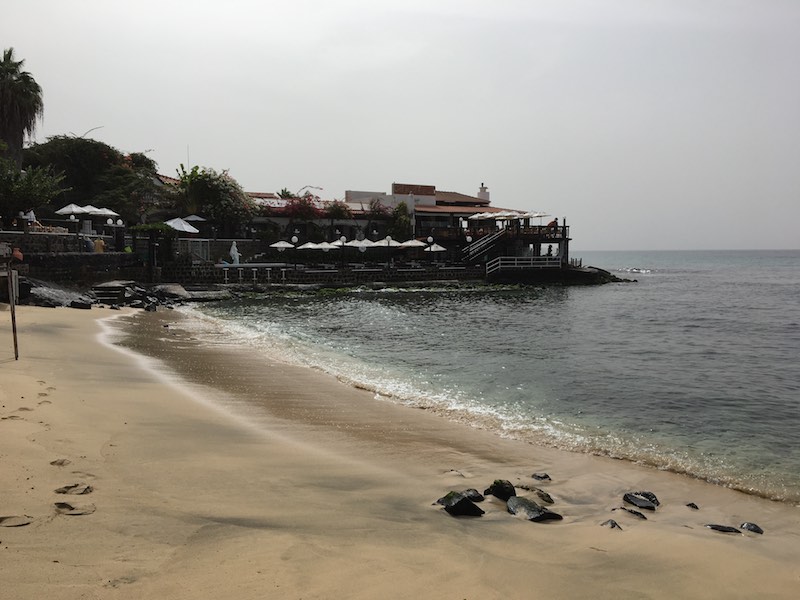
In the afternoon, I decided to go to the beach (2 min walking distance from my hotel) and I've got to say it was really good. The beach was mostly empty, quite clean, and quiet. Really quiet. The water is crystal clear and the sand is almost white.
Full disclosure: this beach is full of boats, motorboats and people practising water sports & activities, so not the best for taking a swim.
For dinner, I decided to try a seafood place, Barracuda, but it was closed, so I went to the sports bar next to it instead.
The Sal Beach Club offered a good serra carpaccio, a grilled tuna steak, dessert (a delicious homemade chocolate cake!) + mineral water for slightly over 20 euro. They had one of these annoying time-limited wifi systems that only lasted for one hour, so it wasn't great to work from there. However, it's a good sport to drink cocktails and watch football.
Things you need to know: Food & drinks
- Don't drink water from the tap. Strongly advised drinking only bottled water.
- Try avoiding raw foods (carpaccios or salads).
- Main dishes come always with salad/fries and come in good portions, so no need to order starters.
Day 3: Sport!
Today, I decided to find out more about how it'd be to live here.
When I travel, I normally use Nomadlist as a guide to finding out how's the weather like, what's the best internet service provider, safe areas and other handy information for people who essentially plan their trip after they've landed in the destination.
Much to my surprise, there was no information about Cape Verde as I'm writing, so I reach out to their founder and offered to collect the info (hopefully, when you read this, they'll be up already).
My Portuguese is very basic, but throughout the years I've picked enough words that I can mix with my knowledge of other Latin languages, so I can get perfectly by and can even get deeper with locals than with English, as most locals have got a more than decent knowledge of English, but for their everyday life, not to talk politics, economy or astrophysics.
I set out to check the beach on the east side of town, only to find it clogged with algae and a rather unpleasant smell (probably because of algae), so I decided to have lunch at Nautic Club Columbus because I had read they've got a good wifi connection.

That information turned out to be false, as I couldn't download files larger than 50mb without interruption. However, I ate a delicious tuna tartar and a fried squid (excessively deep fried to my taste). Service was fast and they were friendly enough.
One thing I've noticed is that most locals will be more friendly if you speak in Portuguese than in English - just so you know it. They're friendly enough, but obviously, being able to use their mother tongue to communicate makes things easier for them.
By the way, make sure you bring your own sunscreen and after-sun. I wasn't paying much attention when I paid 40 euros for both of them in the early morning and now I feel really stupid. What a ripoff.
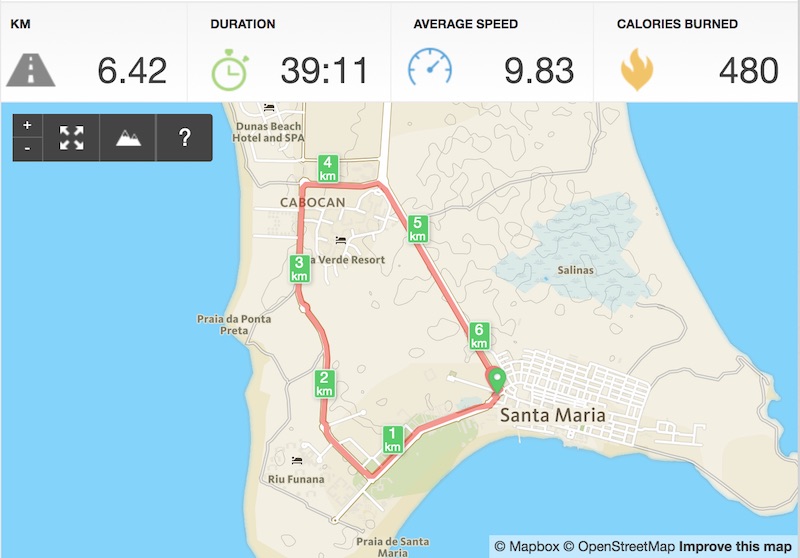
Later on, I decided to explore the other side of the southern bay by jogging. I took a short run when the temperature was actually ok-ish (avoid running between 9 am and 5 pm in the month of November):
After this run, I sprained my back by doing some stupid gesture, so I don't think I'll be working out that much.
Because of the run and the injury, I decided to treat me to a good dinner, and tried this place called Baraonda.
Baraonda is an Italian restaurant, and although I was the only guest there, I've found it to be delicious. It's a little bit on the costly side, but I think prices are fair, considering all the attention and good service I've gotten.
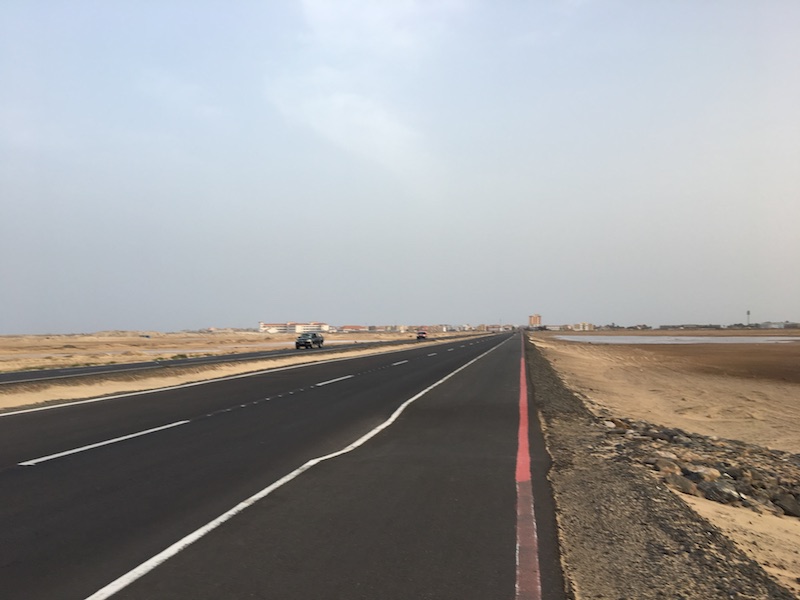
I've paid about 40 euro for a starter, a main dish, a big bottle of water and a dessert. They've been also really helpful answering some questions I had and providing friendly conversation. I will definitely eat there again.
Things you need to know: Working out
- Weather is very warm here (around 30ºC all day round), so work out early in the morning or past 5 pm.
- Hydrate yourself constantly, as you'll sweat a lot during the day.
- If you're a runner, bring good shoes. Most streets are paved with pebbles and you don't want your shoes to break halfway through.
- Since hotel rooms have got AC, you can work out in them.
- If you want to pay for a gym/fitness center, only the top-notch hotels have got one, but I'm not sure you can use them.
- I've seen a couple of yoga places around, in case you're into it.
- There are some workout stations all around the town of Santa Maria, Sal. Not super fancy but definitely worth trying & they're free!
Day 4: Live music!
Not feeling especially well, I decided to take an easy day. Pool in the morning, while I researched the rest of the islands and planned the rest of the trip.
I booked a flight to Fogo to be able to hike to the volcano that erupted in 2014, and extended my stay in Sal until Sunday. The flight cost me 100 euro, but you can get it cheaper if you plan in advance.
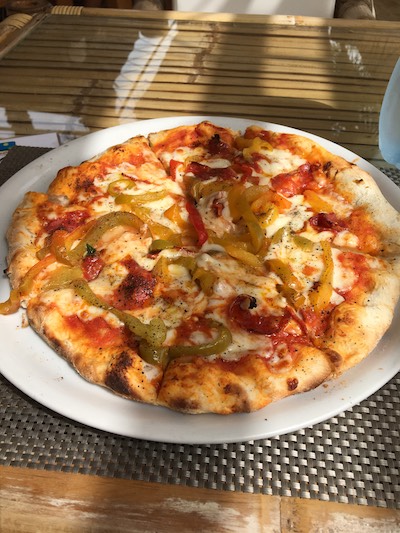
For lunch, I decided to give a second chance to Palm Beach to try their pizza. I have to admit that the pizza was worth its price (800-1200 CVE - 8-12 euro). So kudos to them.
After a long nap by the pool, I felt guilty and decided to go for another run, and repeat yesterday's. Felt extremely good and the weather was slightly cooler, but still really windy.
For the rest of the days, I've used 8fit, which is my fitness app of choice. Perfect for travellers, as it requires little to no equipment at all, and the workouts can be performed virtually anywhere. More on working out in the Things you need to know section.
Since I needed to download heavy videos, I decided to go to Ocean Club Cafe, for its allegedly good wifi connection. The place is pricey and touristy, but friendly enough and looks like a place where I could spend an entire day working.
Probably, the only one in the island.
The smoothie I ordered was tasty enough, but cost 6 euro (holy shit! more expensive than in Barcelona!) and the wifi, albeit stable, was nothing to write home about. I was probably not sitting in the right place, though, so I will have to try it again.
The place is in one of the most centric areas of town, in front of the main square.
While working, I could see how the people of the place were setting up a concert stage, so I went for a quick munch at Kaza d'artista.
Boy, was the food tasty! Prices are more than reasonable and the service was excellent. I ate a starter (cheese + olives) plus a local dish called lula, which is sort of a squid stew with tomato sauce with rice and green peppers that was REALLY good. That, and a big bottle of water, cost me 15 euro. A really good deal, seeing the prices on the island.
After this good culinary experience, I sat among the locals to enjoy live music.
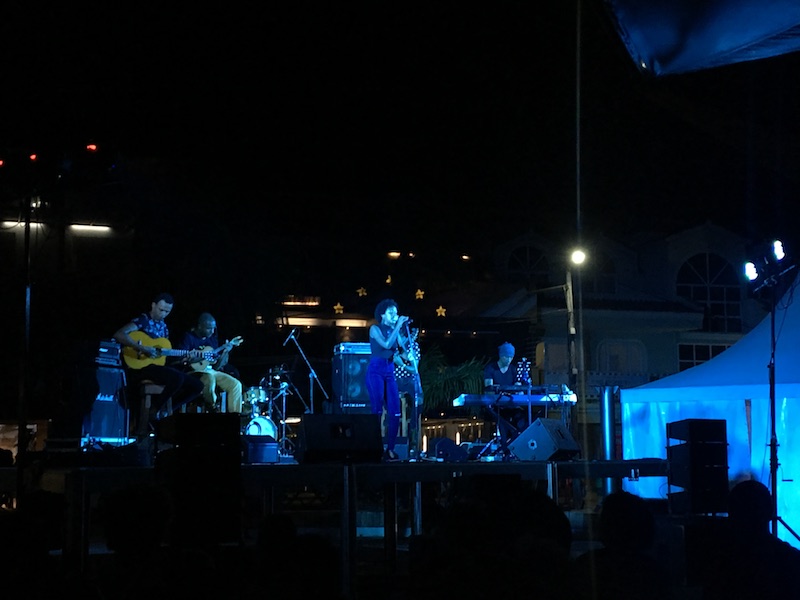
They were celebrating a sort of concert with a live band + many local singers taking turns, interpreting classic songs of their singer-songwriters. I did like it a lot, especially the female voices. Truly stunning voices and easy-listening songs.
Cesaria Evora is the most well-known musical artist from Cape Verde, and some of her songs were played on this show.
About 300-400 people gathered around the concert, elders and children alike, and it was probably the best experience I've had on this trip. Music is the true language of the heart.
Things you need to know: Some basics of Creole
- Olá/Oi: Hello.
- Modi bu sta?: How are you?
- Muitu ben: Very good.
- Bon dia: Good morning.
- N ka ta konprende: I don't understand.
- Bu ta papia Inglez?: Do you speak English?
- Pur favor: Please.
- Obrigadu: Thanks.
- Sin: Yes.
- Nau: No.
Day 5: Beaches!
After some days of feeling sick, I felt very much alive again, so I set out to explore some beaches in the southern part of the island.
To my surprise, the best beach in the southern part of Sal is the one you find right in Santa Maria: crystal clear water, clean sand and an immense feeling of peace. It had fewer bugs than the rest of the beaches I've seen (not that they were annoying like the beach fleas you find in Indonesia, but they're there).
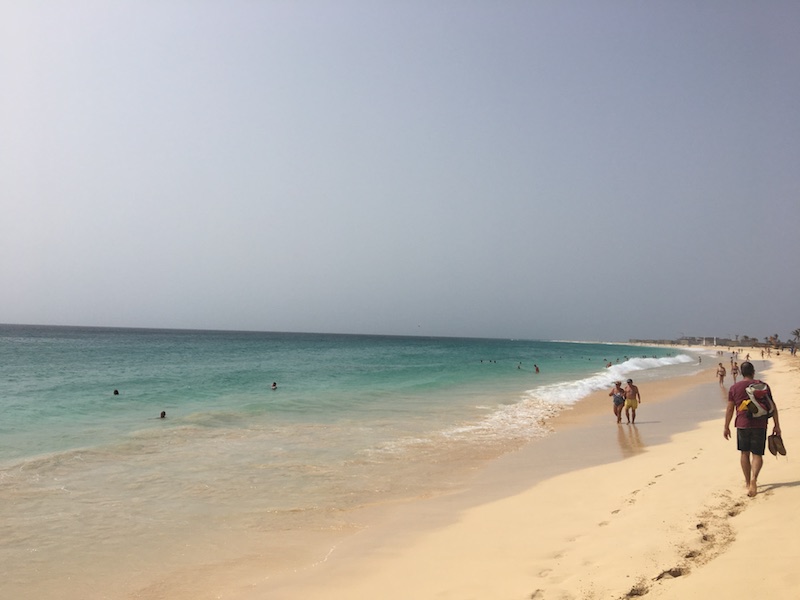
As of this writing, the surfing season hasn't started. According to locals, it starts in November, so that's why it is not crowded now, and mostly full of elders.
Come November, though, and according to locals, the entire island turns into a surfing heaven. And the surfing season ends in March.
Since I liked the place I went for dinner yesterday, I decided to repeat for lunch: Kaza d'artista.
The place is a perfect blend of local cuisine/culture while having interesting dishes. It is also fair-priced (for 10 euro) you can have a good meal, which is about a fraction of what you pay in the others, without sacrificing quality. On the contrary: it's really good food and excellent service. I can't recommend it enough and will most likely eat there every day from now on.
I've been working a bit in the afternoon on some side projects and updating this website, so I haven't had time to do much more.
At night, I went to have dinner to a different place, one in front of one of the main squares, but it wasn't really good (I named it shit place in the expenses report!). Food was average and, although not too overpriced, I didn't like the place.
Noticeably, there were a lot more people on the streets than in previous days. Seems like Thursday is already a lively night out, in Sal.
Things you need to know: Pokémon Go!
- There are two gyms in Sal, where team Red is mostly predominant. Hooray for me!
- There aren't a lot of shop stops, but enough not to run out of items, like it happens in other similar islands.
- No one is doing raids, so it's kinda useless to do any if the CP of the monster is over 15000.
- In this part of the world you can get Corsola, which is exclusive to tropical climates!
- In Sao Filipe (Fogo) you won't find gyms. Only one or two shops.
- In Praia there's one gym in the center of town.
Day 6: Weekend (well, kind of)!
Didn't do much today. I felt like staying in, planning my next steps, reading a lot about the rest of the islands of Cape Verde, and devouring the book I'm reading right now: Sapiens: A Brief History of Humankind. I can't stop reading!
Guess what? I had dinner at Kaza d'artista again. I went for a starter of local chorizo (grilled sausage) with cheese & fries (too common and nothing to write home about) and decided to try another local dish. I went for buzio which is a stew of giant sea snails.
Actually, when you eat buzio, you're eating this motherfucker and its family.

It didn't look too yummy, but I have to admit that it was tasty. If you like octopus, it's also chewy, albeit a little stronger and harder to chew. Make sure you remove the nail before you eat them!
Since I knew it was going to be a long day, with work, exercise and then exploring the city at night (Friday night!), I had a chilling afternoon by the pool and practising Spain's national sport: the siesta.
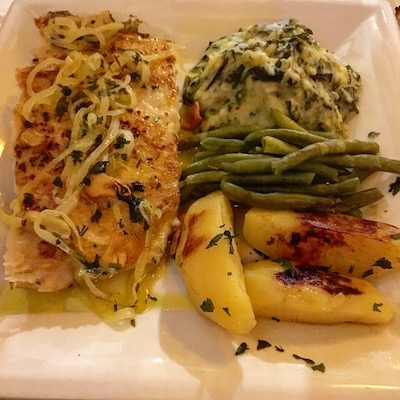
Boy, had I really missed on one of the best restaurants in town! At first, I was slightly defiant of the fact that they claim to be the best restaurant in Sal (sic), but for what I've seen, it most likely is.
I've had grilled cod for dinner and it's been fantastically accompanied with spinach puré, baked potatoes, and some boiled green beans. It is by far the best meal I've eaten in town, and they even brought me some olives & bread for the waiting. Really kind people as well.
I cannot recommend enough that if you're ever in Sal, you try O Caranguejo. Fancy place with really affordable prices. It's small, though, so you might wanna come early or book a table.
The night went by going around town and seeing live music being played in every second block. In six days I've seen the ins and outs of this city about 300 times. However, I have to admit that it's been different every day, and way more interesting and culturally appealing as the weekend grows closer.

Let me offer you a selection of the best bars I've seen so far.
Things you need to know: Bars & live music
- Actually, Kaza d'Artista is a live music bar as well and has got folk music almost every night (except Mondays if I recall correctly). Very much for locals.
- More touristy, but decent rock is being played at Buddy's.
- If you're into classy places with electronic music (I know jack shit about it), then check the Chillout.
- I've seen live music as well in the Columbus, but it was very generic and mainstream so I didn't bother stopping by.
- There's a really cool bar for reggae music with a rooftop, but I forgot the name of it. It's the only reggae bar, so ask around. Looks sketchy from the outside, but the terrace is so cool.
Day 7: Last day in Sal!
After a week here, I'm starting to get the perspective of things.
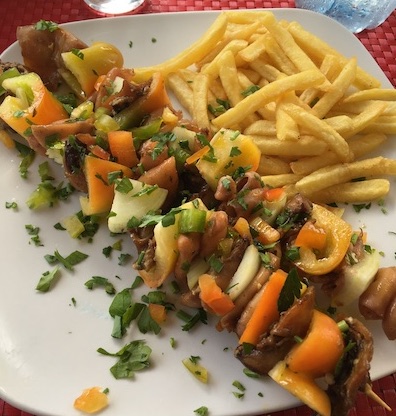
First of all, it is difficult to work from here if you need a good internet connection. Most will do for just email and basic browsing, but I haven't come across any reliable, stable, high-speed connection. Not even remotely close.
This is the biggest impediment for some people to come and work remotely from here (downloading big code repositories? uploading videos? forget about it).
Another thing is the local cuisine. Most dishes are highly loaded with carbs, as it's always meat or fish + french fries or rice. Some places offer to change it for salad or boiled veggies, but it's not everywhere.
Most of all, you don't wanna risk it with the salad, as it's washed with local water and your stomach is not prepared to deal with their local bacteria. However, this is a roulette and sooner or later you'll be caught!
Therefore, if you come to do a detox diet, this is not the place.
Anyways, I've planned my future steps in this archipelago:
- Travel to Fogo tomorrow through Praia (no time to see anything, though).
- Potentially hiking up the volcano if my shoes allow me.
- Travel to Maio on Wednesday to see the allegedly best beaches in Cape Verde.
- Travel back to Sal on Saturday to see the north of the island before buggering off back home.
Lunch at Kaza d'artista again. Second day in a row asking for Bitoque without success. I went for the shellfish skewer instead and found myself eating buzio again (see yesterday). Tasty, but, again, too many french fries!
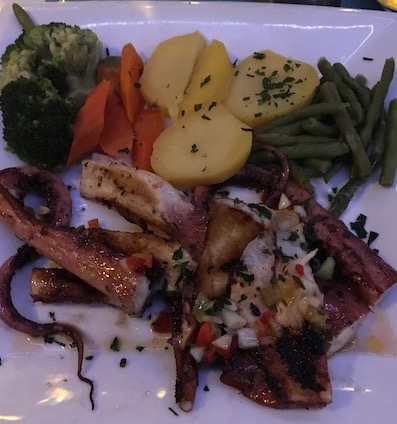
Ran that route from the previous days for the fourth time. It's a good workout, with no traffic and no stops. 30 min solid run for the win. Treated myself to frozen yogurt from the main street afterwards, but I wouldn't recommend it. It wasn't great.
For dinner, I went to O Caranguejo again and had the grilled octopus. Probably, one of the best octopus meals I've ever had. Definitely, the best restaurant in town.
Funny thing: I didn't have enough local currency to pay for the dinner, so I wanted to pay with credit card. Turns out that at night reception is lower (for whatever reason) and the card reader wasn't getting any signal. Luckily for me, I could pay half in euros, half in Cape Verdean Escudos.
During the weekend, the whole main street is closed to traffic. There's a concert in almost every bar, so I spent most of the night listening to all sorts of music being played by the locals (reggae, folk, acoustic pop/rock classics, local singer-songwriters, etc.).
Things you need to know: Water
- One of the first days I experienced the effects of having eaten something funny. Most likely, some fruit/salad washed with their local water.
- It only lasted for a day, but keeps you at home the entire day. Not as bad as the Bali belly.
- Drink only bottled water.
- Try avoiding raw foods like salads, tartars and carpaccios.
- Want a fruit juice? Ask for milk instead of water.
- Also, ask for drinks without ice.
Day 8: Flying to Fogo!
Today, I'm writing from Sao Filipe, Fogo.
There are no direct flights from Sal to Fogo, so I had to change flights in Praia. The first flight was about 40 min (Sal-Praia) whereas the second one lasted for barely 20 min.
The airports are very small and they're not crowded at all. Showing up one hour before the flight departure is more than enough. There's plenty of time to do everything.
One good thing about the airports here is that they seem to have lots of available sockets. Good for charging the phone or for working from there with the laptop.
Food at both airports ain't nothing to write home about, but it's not overpriced at least. I bought a water and a sandwich for about 2 euro.
All flights between Cape Verde islands are operated by Binter, a small airline connecting Cape Verde, Morocco and the Canary Islands (Spain). Their website is horrible, with a rather misleading UX, and it's only available in Spanish and Portuguese.
Their planes are the smallest I've seen so far, but they give you a snack and water during the flight, which was unexpected and came in really handy. Their staff and service are really good overall.

One thing worth mentioning is that I won't be able to visit Maio because the flights are full. Lesson learnt: small planes fill up fast. Plan ahead.
So what I've done is to book my next to flights: one to go to Praia and explore it for a couple of days, and the flight back to Sal, from where I will depart on Sunday morning. While I was at it, I also booked the hotels because I've seen that both cities were also filling up fast.
I haven't seen much of Sao Filipe (capital of the island of Fogo), because I've spent the afternoon planning the trip to hike the Pico do Fogo (active volcano that erupted in 2014) tomorrow in the morning. Actually, I'm waking up at 5am, so I literally had dinner at 7pm and am headed now to sleep.
Taxi from the airport to Sao Filipe should cost between 2-4 euro depending on where you are. I am sleeping at Hotel Ocean View & Restaurante Seafood. I really don't recommend this place unless there's nothing better in town. The area doesn't seem to be the best and the "hotel" (more like a pension) is still being built. Seems kinda dodgy, but I had no other option so I planned the hiking trip to the volcano with them (I've researched the price and taxi both ways + guide for about 80 euro seems like a fair deal). You can go lower than that, but I paid for the convenience of not having to search and because I think it's a fair price.
Things you need to know: Airports & domestic flights
- Airports are small and easy. Don't waste time going too early.
- Everyone speaks English. Staff are quite helpful all the time.
- Some don't have QR code readers for your electronic tickets, so have them print them at the check-in counter.
- A small snack & water are provided during flights.
- Book early: small planes fill up soon.
- Most flights range between 50-80 euro in price even if you book them the very same day.
Day 9: Hiking up Pico do Fogo!
When the alarm went off at 4.45am, I expected to have one of the worst days ever.
I slept about two hours, drenched in sweat, and terribly disturbed by the noise inside the room (AC + fridge) and outside (really windy night, dogs barking & cocks singing).
Even more so, when I was given the two worst sandwiches in the world for "the way up".
My driver picked me up at 5.15am as appointed, to take me to Chã das Caldeiras, the closest village to the active volcano that reigns the island of Fogo. Coincidentally, that town is the one that got trampled under lava during the terrible 2014-2015 eruption. Read more about it in the Wikipedia entry about the Fogo volcanic eruption.
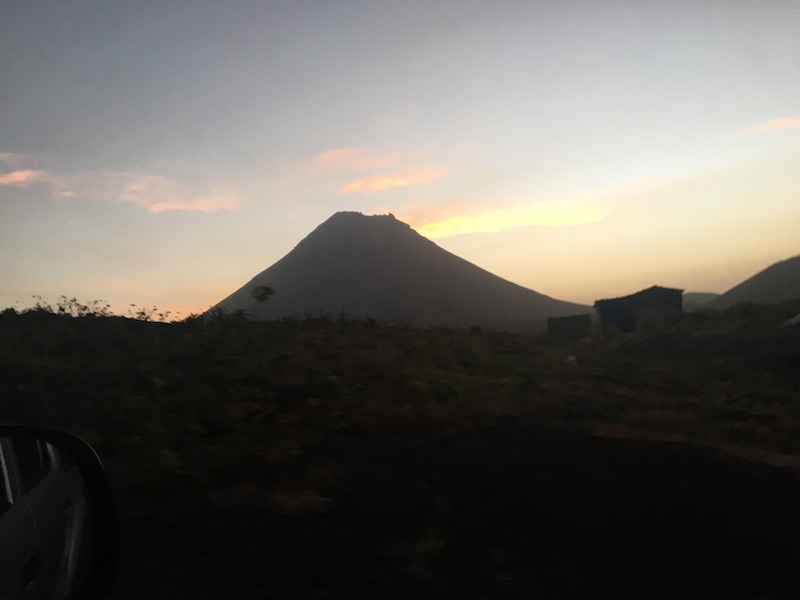
Their population fled the area to nearby towns and had to reconstruct their life from scratch. No one died, luckily.
As soon as we were getting close - after circa 90 minutes driving - I understand why this place is so unique in the world, and failed to comprehend how it isn't crowded with touristic attractions.
Perhaps is because it happened too recently (lava stopped coming out in February 2015 - after 77 days of activity), perhaps is because Cape Verde still lacks the infrastructure to provide good touristic services. Either way, it is clearly none of my business, and I enjoyed the feeling of being almost the only person doing it. We only saw two people doing the hike during the entire day.
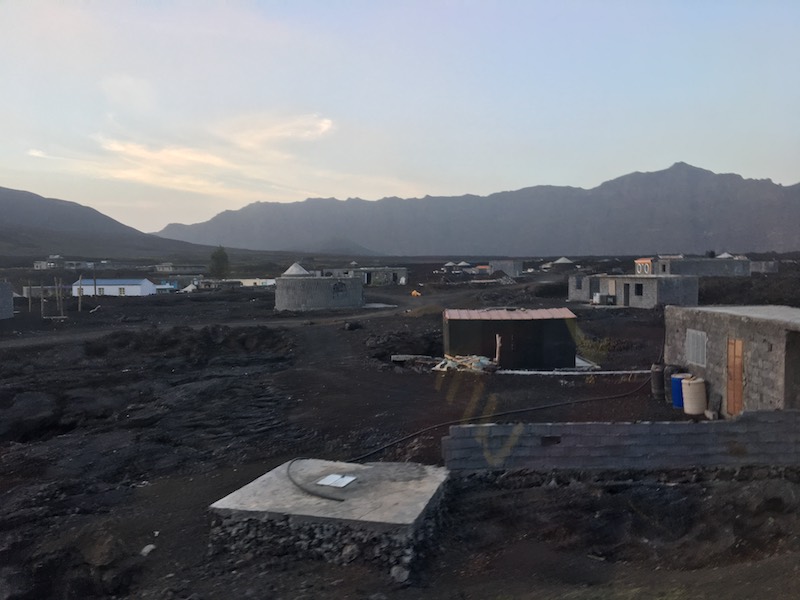
Upon reaching the village, where we greeted the local guide, I was surprised with the vast immensity of black lava flooding the entire place. Actually, the drive is 20-30 minutes longer because the road was cut by the eruption and they had to circumvent the gigantic mass of black tectonic vomit.
Outside of the lava, the place looks like the surface of the moon, at times, or the surface of Mars, depending on the colour of the surface.
We arrived at about 6.30am, and very diligently commenced our way up. All the way to the top of the main crater is a three hours hike if you stop. We did just a small break, as we are both fit, and completed the hike in slightly over 2.5 hours.
The way up is not for everyone, and certainly less so for the faint of heart. The main difficulty resides in the way being paved with gravel, which makes you slide down a bit every time you miscalculate a step.
Good hiking shoes are advised. Not so much for the grip, as for the ability to lock down your ankles & don't allow these small rocks to get into your shoes. It is really annoying, because at times you're ankle-deep into the black gravel.
Once up, the view on either side is incredible.
Looking back to whence we came, Chã das Caldeiras looks like this:
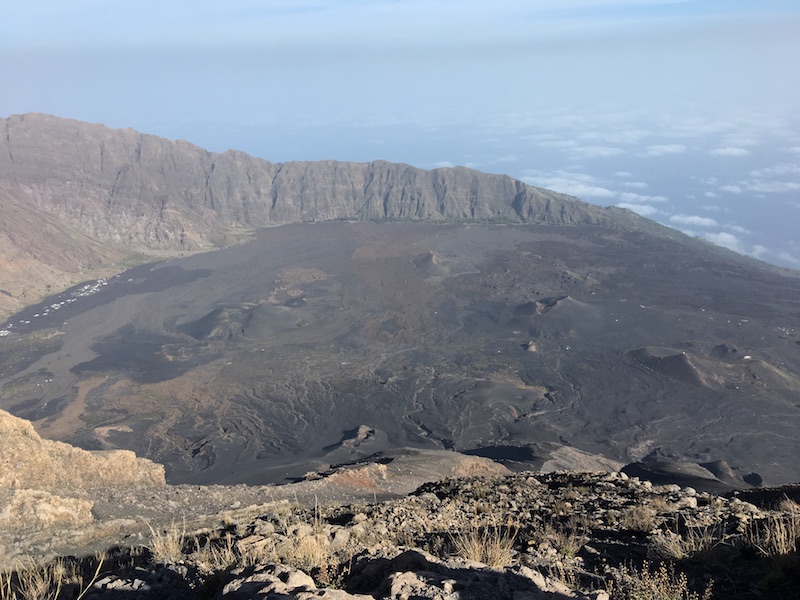
Looking into the big crater, it looks like this:
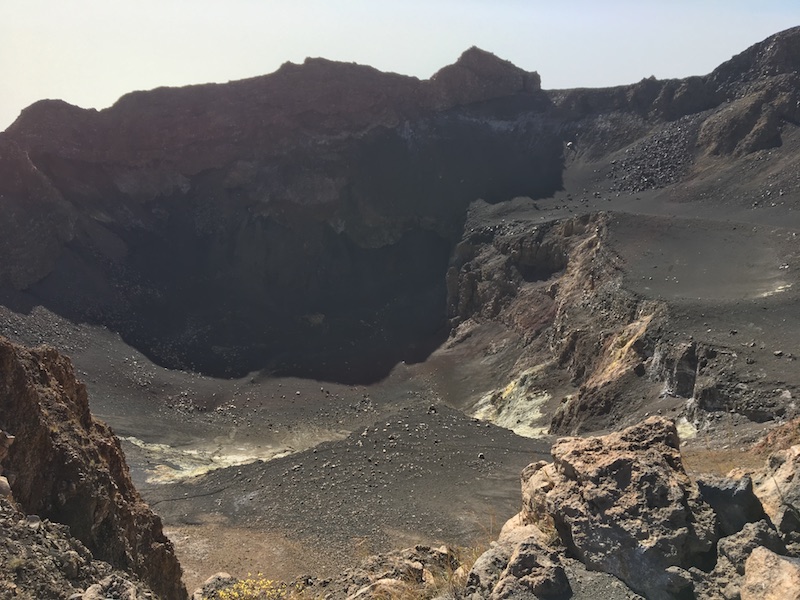
Stunning both views. Up there, at about 10am in the morning, it was sunny enough to dry the sweat, but also windy and slightly chilly (it's later October), so bringing a good wind-stopping jacket doesn't hurt. And don't forget the sunscreen, a cap and sunglasses.
Since I hadn't planned to do this hike, literally I did it with running shoes, no jacket, no sunglasses, no cap and just the sunscreen. Go, me!
After a well-deserved break, and a good conversation, we decided to continue our way up a little bit more to get closer to the top of the mountain, but decided to take another way to see the 2014-15 eruption crater and do The Best Thing Ever™.
The hike continued for an extra 30 minutes, up and down, to circumvent the top of the mountain (we reached an altitude of 2658 meters).
And then: The Best Thing Ever™
We literally slid all the way down on our both feet, for a good 10-15 minutes run. It is decidedly one the most fun things I've ever done.
Here, good shoes are important, to avoid potential ankle injuries and to ensure the little black gravel doesn't get into your shoes, thus hurting & limiting your movement.
As I read somewhere, prepare to be mighty dirty. I ended up all black from the waist down from all the volcanic emanations of the surface we were sliding on.
I also got some cuts & scratches on my left arm but I seem to recall that I fell before the slide thing.
Once down, and after very laboriously having removed all the sand, rocks and dirt from our socks, shoes, and feet, we cooked some popcorn using purely the earth's warmth, close to the 2014-15 eruption crater. Here's the video:
Once the tour was over, clocking in about 4 hours in total, we drove back to Sao Filipe for lunch.
I decided to go for a swim in the ocean, but I was strongly advised not to do it because of the heavy currents. I, however, had another life-changing experience.
First of all, the beach right behind my hotel has only black sand. It is a purely volcanic beach. I had seen mixed sand before in the Canary Islands and in Bali, but nothing as dark as this sand:

It looked fake.
The thing is, for the two hours that I roamed the beach, I saw not a single soul there, which was slightly discomforting at the beginning, but then I got used to it, once I found a good reading stand where I spent one hour reading.
That pretty much sums my day. I'm knackered, and I just look forward to eating dinner (my third meal at the hotel I'm staying at - literally there's NOTHING to do/see in Sao Filipe) before going to sleep & fly early morning to Praia.
Things you need to know: Cleanliness
- One of the things I've noticed is that in Cape Verde there are almost no insects.
- I've only seen one cockroach in 8 days. Not even dead ones.
- Also, I haven't been bugged (no pun intended) by mosquitos.
- Haven't seen a lot of stray cats/dogs either. That means fewer fleas.
- However, as it is the case in underdeveloped areas, cities aren't precisely clean, so watch your step.
Day 10: Exploring Praia!
Catching the early flight at 8:45am, I reached Praia at ten past nine in the morning, or so. That flight is so short, it is ridiculous.
I had been asking around about the safety in this island, and I didn't get the most positive answers. Since it is the capital, it is the biggest city, and therefore there's a lot going on - meaning crime.
I almost witnessed a knife fight immediately upon boarding my taxi. When my driver wanted to leave the place, another taxi driver shouted at him and they began discussing from inside their respective cars. At a certain point, my taxi driver slowly pulled a knife to keep it close to him, but I think the other dude didn't see it.
Fortunately, they decided to leave it like that and headed off towards my hotel. I was sitting in the backseat, and could see him playing with the knife all the way to the hotel. I was kinda worried.
I started getting nervous as I saw him missing a turn and going somewhere else, drifting away from the direction of the hotel. When I confronted him about it, he told me we were on the right way.
Turns out, he was right, and nothing happened. Just that the Booking.com address of the hotel I was staying in was wrong.
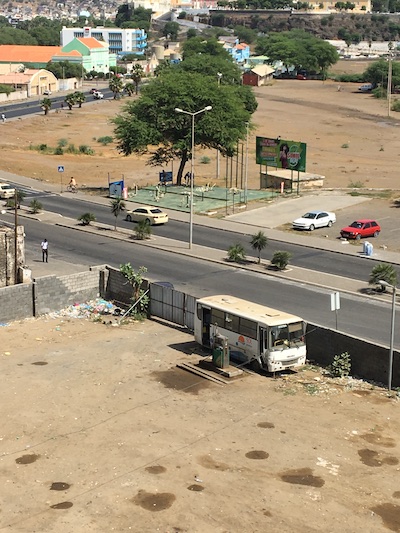
I decided that after the bad experience in Fogo, I would treat myself to a good hotel, so I chose Hotel Pérola.
It's a four-star hotel with really good rates. If wifi was more stable, it would be one of the best hotels I've ever been in: good rooftop swimming pool, a small gym, everything's brand new, very spacious and comfortable room, and a terrific restaurant. Prices are good, so I'm eating most of the time here because the quality is excellent and the service is outstanding.
On my first day, though, I decided to explore Praia.
I walked to Prainha, which is supposedly one of the good beaches in the city (the main one is horrible, as it's home to the port of the city), and struggled to find any restaurant open. While the beach was nice from far, it was also far from good and was definitely not very clean.
I had to eat in a beach bar where they spoke no English. That speaks at length about how non-touristy this area is. I tried googling what's nice in the area, and there's a couple of statues, the beach and a lighthouse, but really, you can skip this part of town. I walked for about two hours and didn't see anything worth reporting.
They told me to go to the old city (Cidadela), which I might do in the following days.
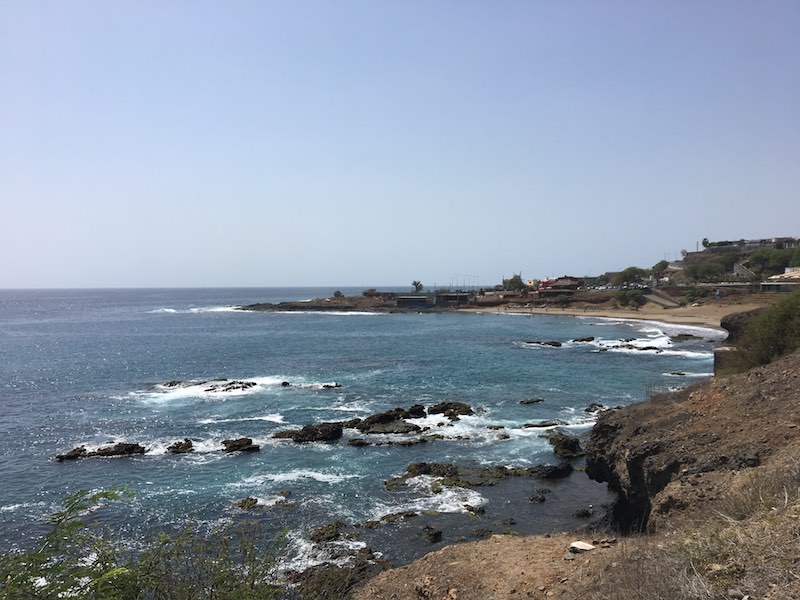
Even if you're not staying in this hotel, you need to come for lunch. It's got fair prices (for Europeans, I guess) and it's definitely cheaper than any place in Sal.
Things you need to know: Safety
- Sal is 100% safe everywhere. I never felt threatened not even in small dark streets. There's virtually no crime there.
- Sao Filipe, in the island of Fogo, is different. It's a much poorer area and people will beg for money in the streets. Occasionally, one can pull out a knife or a gun to take away your money, so don't bring much on you (never happened to me because I didn't wander around at night). When I had to go to the ATM at night, they drove me there and kept me safe.
- Praia is definitely the most dangerous of the three. There are several zones where you're not supposed to go not even by day (ask around), and most definitely you don't wanna go out at night alone. If you need to, take a cab and just the bare essentials (no excess money - or no wallet at all if possible).
Day 11: Lazing around
Being trapped at nights in these two islands, Fogo and Praia, because it's dangerous to go out while it's dark has allowed me to read a book every day.
I have been binge reading in the last three days and I decided to spend the day in, reading, working out in the gym, chilling by the pool and getting some shit done on the computer.
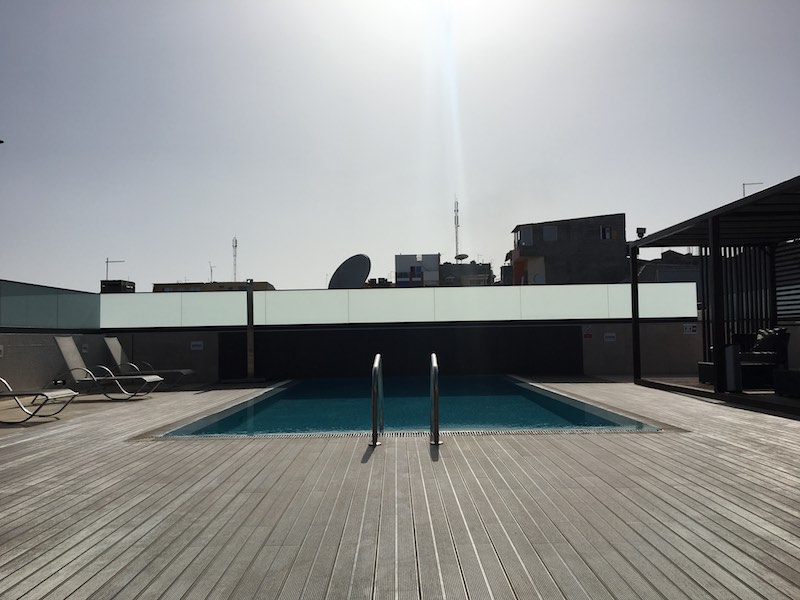
Wifi hasn't worked for most of the day, and at about 6pm there's been a series of blackouts all around the city (I was drinking a juice at the terrace and saw all the city lights go out at the same time). I've also had a couple of them being in the room.
Things you need to know: Currency
- 1 euro = 110 CVE (Cape Verdean Escudos) at the moment of writing this post.
- Virtually everyone accepts euro at the exchange rate of 1 euro = 100 CVE.
- Not ideal, but convenient at times.
- Some even accept being paid part in CVE and part in euro.
Day 12: Things to see in Praia
Feeling slightly guilty of not having left the hotel the day before, I set out to see the center of the city.

I took a short walk of 10-15 minutes to the center, which is where all the main buildings are. It's a nice area, a little bit uphill (called Plato, from where you can enjoy a broader perspective of the entire town.
The place must've been some sort of a fortress, as it has cannons facing the sea, probably to defend the city back in the day.
In here, you can see some statues, main buildings like embassies and military offices, and the main market and mostly all the things worth seeing in Praia as reported by Tripadvisor.
Take your time and explore the area. It's not big, but definitely I was the only tourist around, and could feel all the eyes on me all the time.
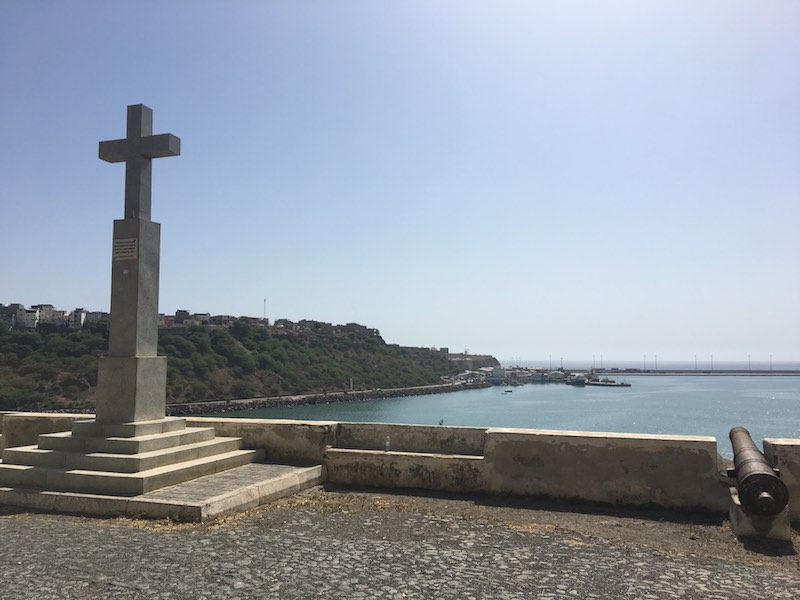
If you've got time, you can go and check Cidadela (Old town). I will always remember the puzzled looks of the receptionists in my hotel when I asked them "what's interesting to see in this city?". They told me that "literally, nothing, but I've heard people like the center (Plato) and some like Cidadela". It appears, Praia is a city for business - as the capital of the country -, and tourists don't ever come here. In fact, pretty much everyone in my hotel was talking business all the time.

I didn't go to check Cidadela. A quick search on Google made me stay in the hotel instead planning my next trips & getting shit done for when I'm back in Barcelona.
Things you need to know: Meeting locals & dating apps
- Cape Verde lives in a culture of open-mindedness and respect, for what I've seen.
- Although they seem to try to get easy money from you (especially taxi drivers & small supermarkets/produces), it's quite normal to talk to people and most enjoy it.
- I'm staying for a short time on every island, so I can't make friends. Although I seem to engage in interesting conversations with people at the hotels/restaurants.
- Extra points for you if you manage to prove you're not the average white tourist that doesn't care about local culture or language. They appreciate it A LOT if you try to speak their language - even if you fuck up constantly.
- As for dating apps: ABANDON ALL HOPE YE WHO ENTER HERE. Empty.
Day 13: Back to Sal!
An early morning flight saw me flying back to Sal. In Santa Maria, I will spend my last two days of the trip before embarking on the return to Barcelona.
I had an unfortunate event with the taxi driver taking me from the airport to my hotel in Santa Maria.
I asked him how much to take me to town, knowing that 1000-1200 would be a good price. He said 1200 CVE, but I told him 1000 and he agreed. There wasn't much of a difference and they probably bring locals for a fraction of that.
When we arrived, I had nothing but a note of 2000, so gave it to him, and he didn't give me the right change. He told me "I told you 1200" and left.
Lesson learnt: If you're going to barter with a taxi driver, give them the exact amount of money.
I went for lunch to my friends at Kaza d'Artista again and had a delicious pork cotelette. It was their dish of the day, and it was fantastically accompanied with rice, salad, baked potatoes and some fruit. Tremendous deal. Definitely a really good restaurant with friendly staff.

This time, I'm staying at the gorgeous Budha Fashion Beach Club, which is a new building (a bit of a walk from the centre, to be honest), but beachfront and gorgeous infrastructure.
In my trips, I always like to treat myself the best I can for the last night or the last two nights.
This place is fantastic. It's got wifi everywhere, a very nice pool, it's directly on the beach and the food is spectacular. If there's a place to work from in this island, it is definitely this one bar none.
For digital nomads, it's also a good option. It's not super expensive, and it couldn't be closer to the beach, which is good if you surf - plenty of surf houses around.
Things you need to know: Drugs
- Cape Verde has got strict laws on drugs, but mostly tied to jailing you and having to pay a fine. No death penalty like in other nearby countries.
- Some people will sell on the street, but it's not very common. Seen it twice or thrice in two weeks.
- Lots of people smoking joints, thought, but it's not the main reason for tourism unlike in other parts of the world.
- Being so close to some of the biggest producers of hashish in the world, I expected to see more culture around that.
- Alcohol is the main drug around here, and the prices are pretty much standard (European standard, I guess). Beer for 3 euro, cocktail 5-10 instead.
- Lots of European beer. Mostly Portuguese and Czech.
Day 14: Definitely fell in love with Sal
Being away from Sal for almost a week certified what I reckoned it would happen: I've fallen in love with Sal. To be more precise: with the city of Santa Maria.
In slightly over a week spent on this island, I have found pretty much everything I wanted to find: relax, good food, friendly people, nice beaches, amazing weather and a spot from where I could get shit done with my laptop.

Santa Maria offers a very welcoming environment and most of all, it's one the safest places I've ever been to. I appreciate this a lot.
I can only regret not having planned with enough time to book some flights to Maio, instead of Praia, but I'm convinced that I will come back. Next time, Sal + Maio and maybe a third island.
My last day in Sal has seen my doing what I've been doing in my last days here: working a bit, reading, relaxing, eating good food, going for a run and then watching concerts to wrap up the night.
I can't stress enough how amazing Budha Fashion Beach Club. Make sure you select "Breakfast & Dinner included". Although it might look a little bit pricy, if you're here for two/three days it's an amazing experience.
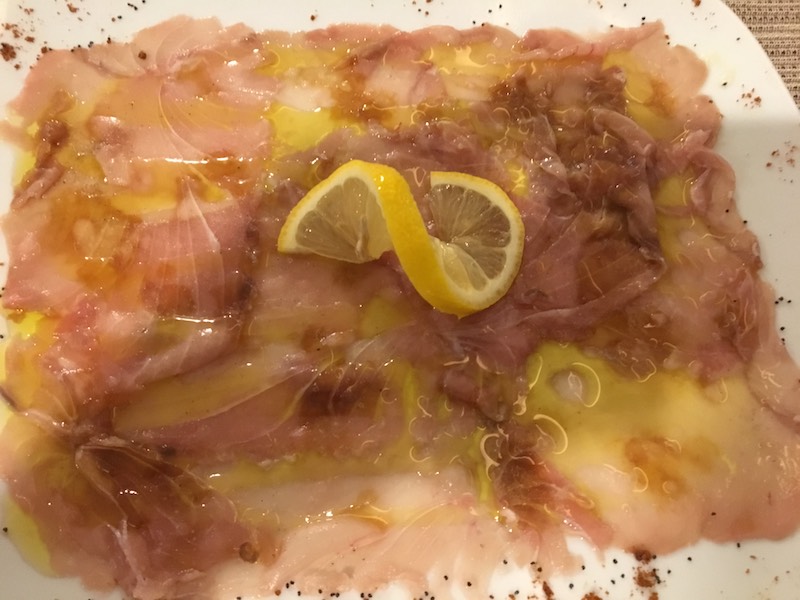
The food is fantastic. The best I've eaten in the entire trip, with an outstanding tuna carpaccio, a delicious chicken with soy rice and my favourite dessert in the island: Gelado de Bolacha (cookie ice-cream). The breakfast options are really phenomenal as well: both abundant and tasty.
Things you need to know: Essentials
If you're going to do this trip I've done: two beach islands + one hiking trip, you'll need this:
- Beach stuff (snorkeling mask, towel, flipflops, etc).
- Sunglasses.
- Hiking shoes.
- Sunscreen (high protection factor!)
- After-sun lotion.
- Mostly summer clothes.
- Light jacket for the hike.
- A cap is advisable to protect from being all day long under the sun.
- Passport photocopy just in case.
- Multiple VISA cards in case yours gets lost/stolen/blocked.
- No socket adaptors if you come from Spain.
Day 15: Going back home (summary)
After having spent two weeks in this beautiful country, I can certainly say that I will miss it.
On the wait to the airport I felt strangely attached to somewhere. Most likely, I will only miss Sal, out of the three islands I visited in total, but I also feel I would've loved Maio - even though I wasn't able to visit it on this trip.
I will have to come back.
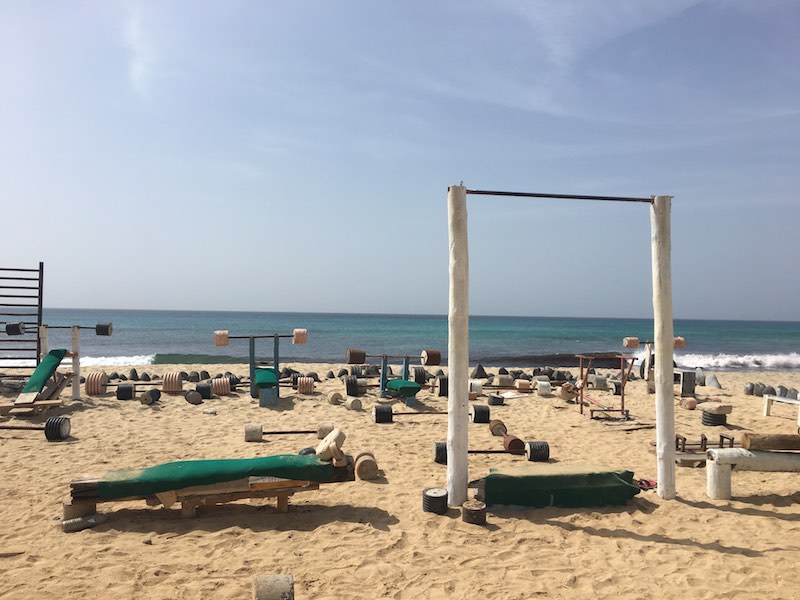
In hindsight, I think my trip has felt a little bit too long, and that I should've visited at least another island. However, since I came with little to no preparation and all, my satisfaction level is very high and I think I did my best.
I also came with moderate expectations and a very low desire to explore too much, as the purpose of my trip was complete relax & soaking local culture by living a quiet life, undisturbed by excessive trips & activities.
Following my reasoning, then, I am very glad I visited Cape Verde and I can safely say that I will return to visit the remaining islands.
I've done life-changing things, like hiking up & running down an active volcano, running through the desert in Sal, or spending over two hours completely alone on a black sand beach in Fogo.
The only thing I'd change is having spent three days in Praia. I didn't like it at all, but because I didn't prepare enough, all the flights to other islands were full, so I was kind of forced to spend three days there. Three days too much, as the city can be seen in barely an hour and doesn't offer anything extraordinary to make you stay overnight.
Anyways, hope this read has been useful to you and do not hesitate to contact me for further questions, by using the comments section below or via email.
Things you need to know: TL;DR (Too long; didn't read)
Here's a quick recap of what this guide is about:
- I went for a 15-day trip to relax to Cape Verde - a good country to do that.
- No preparation required (no vaccines, no special visa), so I improvised most of my trip.
- I visited the islands of Sal (really good beaches), Praia (capital), Fogo (active volcano).
- Sal was my favourite island, offering fantastic beaches, nightlife, and a very safe environment.
- Praia was a waste of time: nothing to see and completely not safe.
- Fogo is a must because of the hiking trip to the active volcano. The rest is meh.
- Flights between islands are few and fill up quickly. Better book in advance.
- Don't expect a cheap trip: it is rather expensive.
- Visiting in October has proven to be a good decision: high season begins in November so I avoided all tourists.
- I thoroughly enjoyed the trip save for my stay in Praia. I wholeheartedly recommend you to visit Cape Verde.